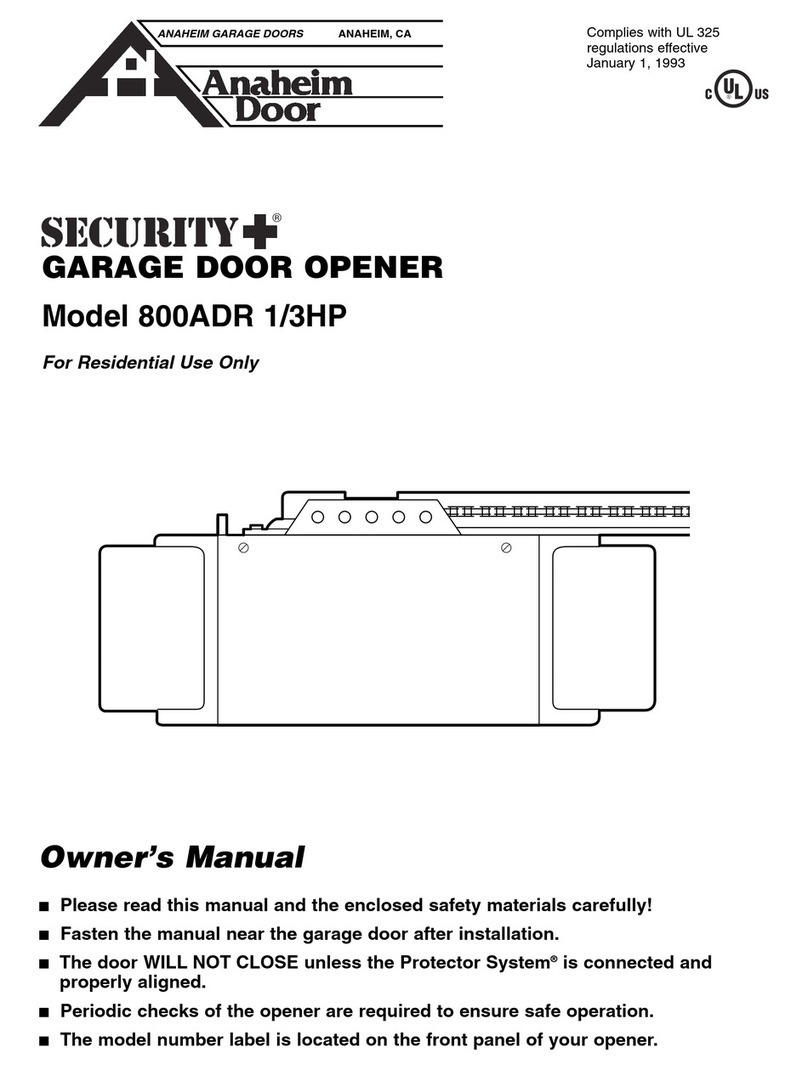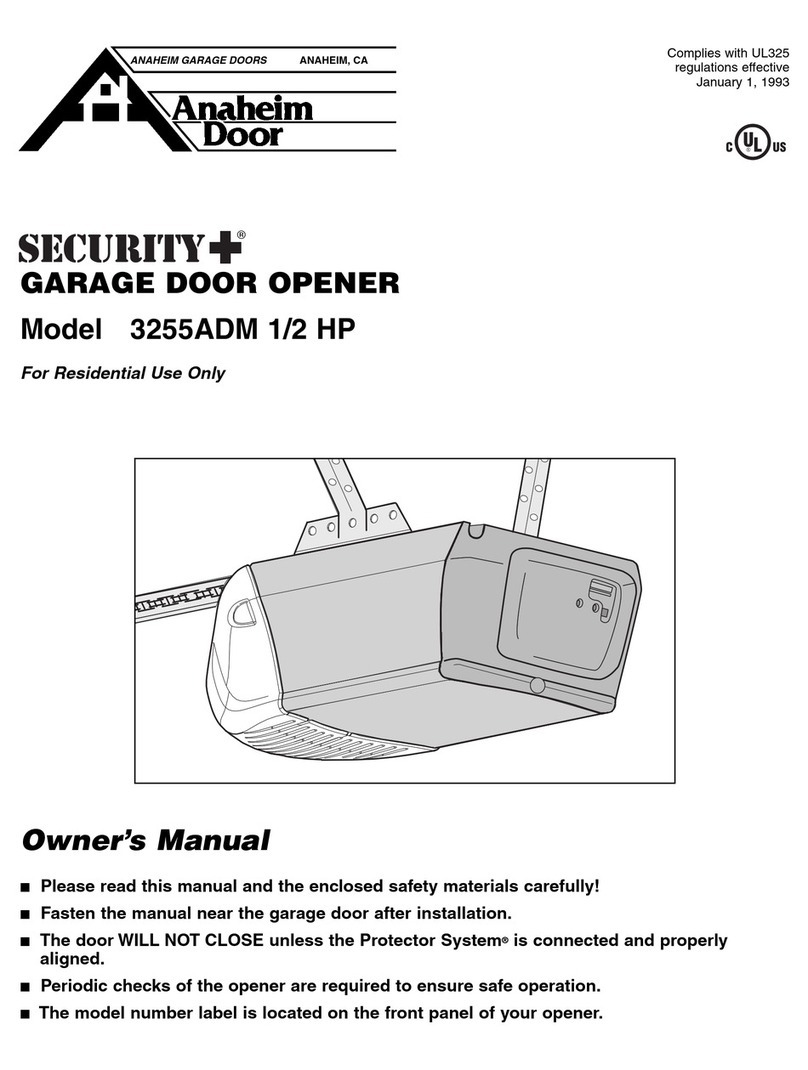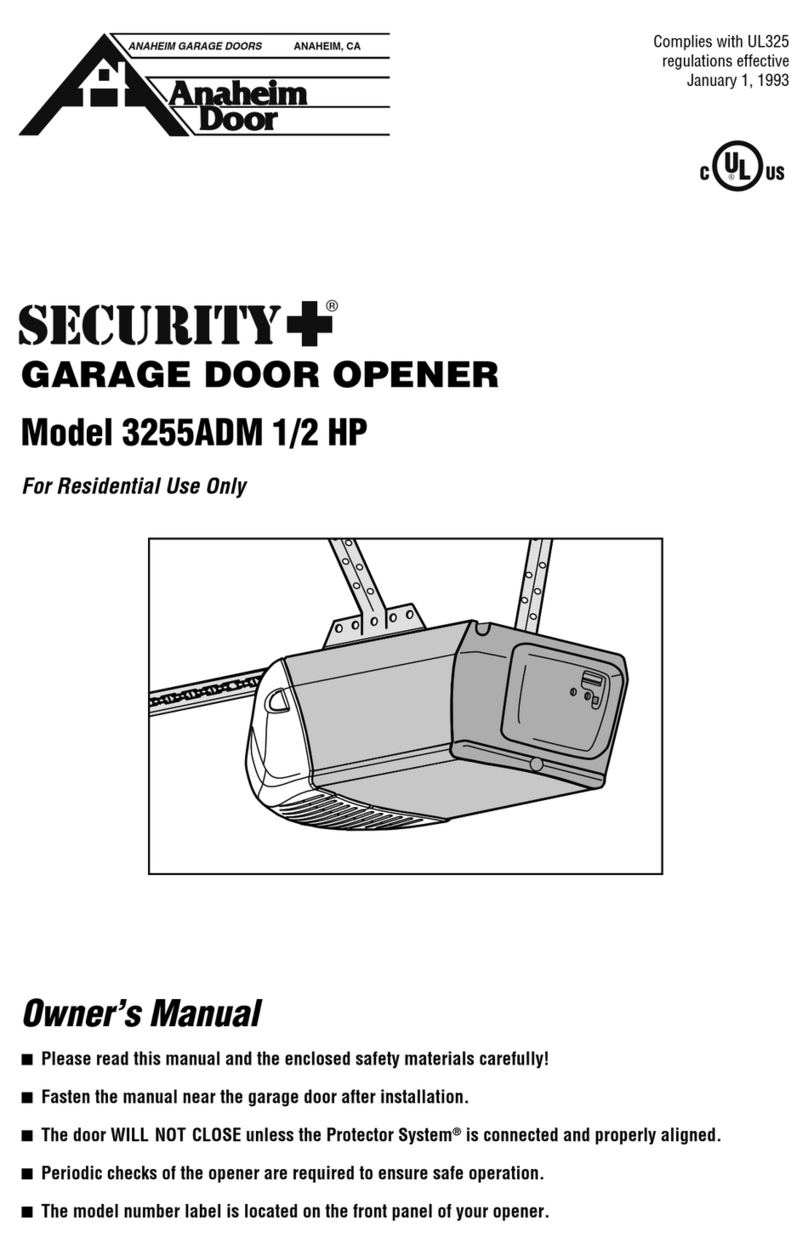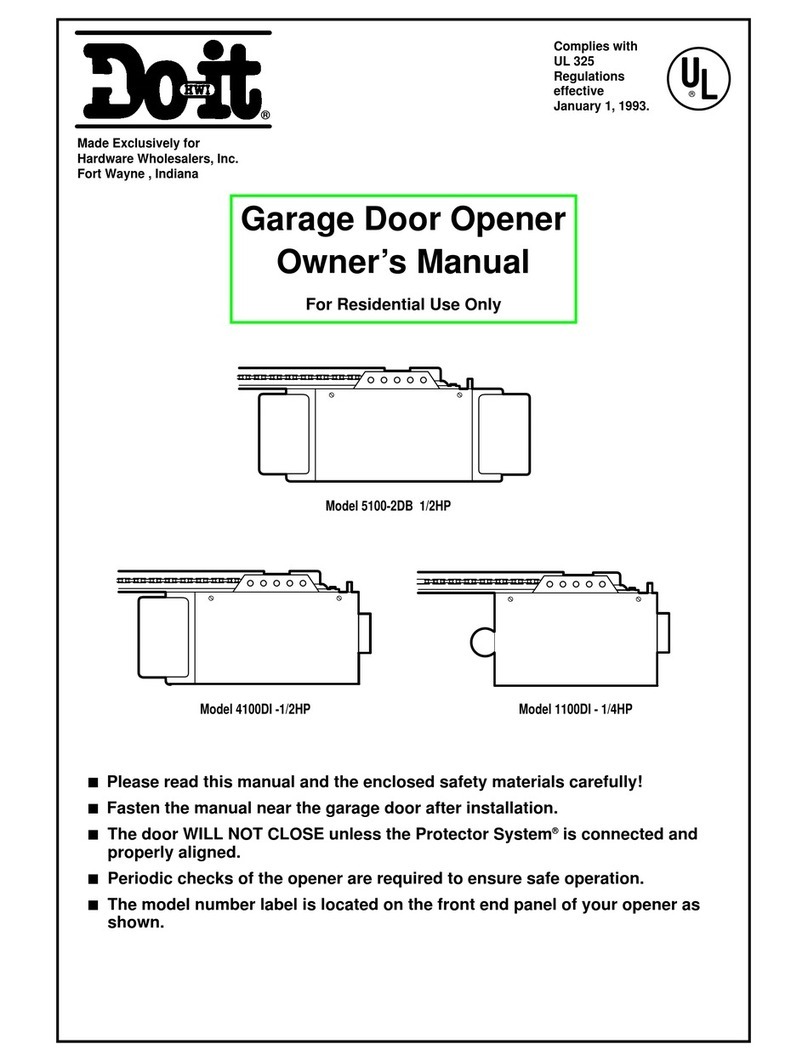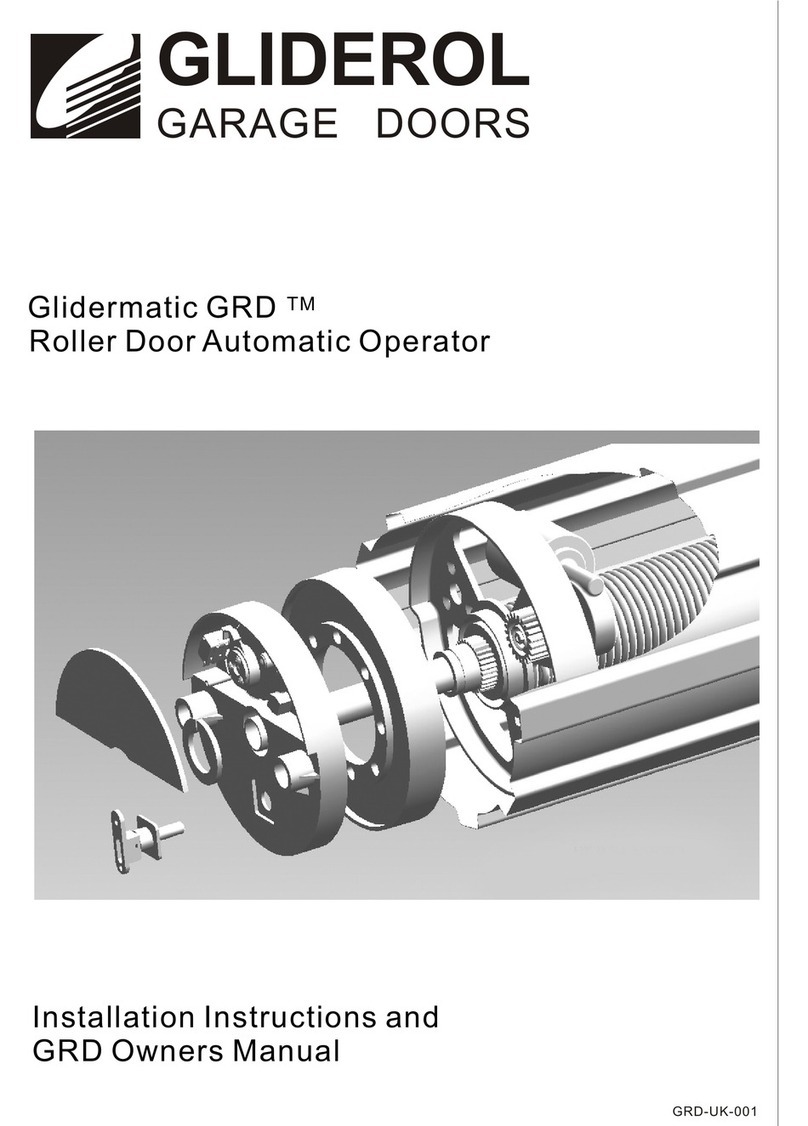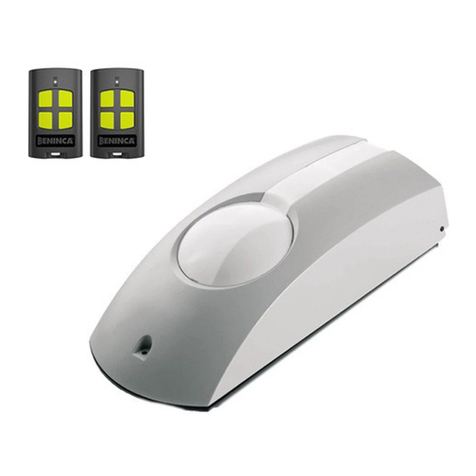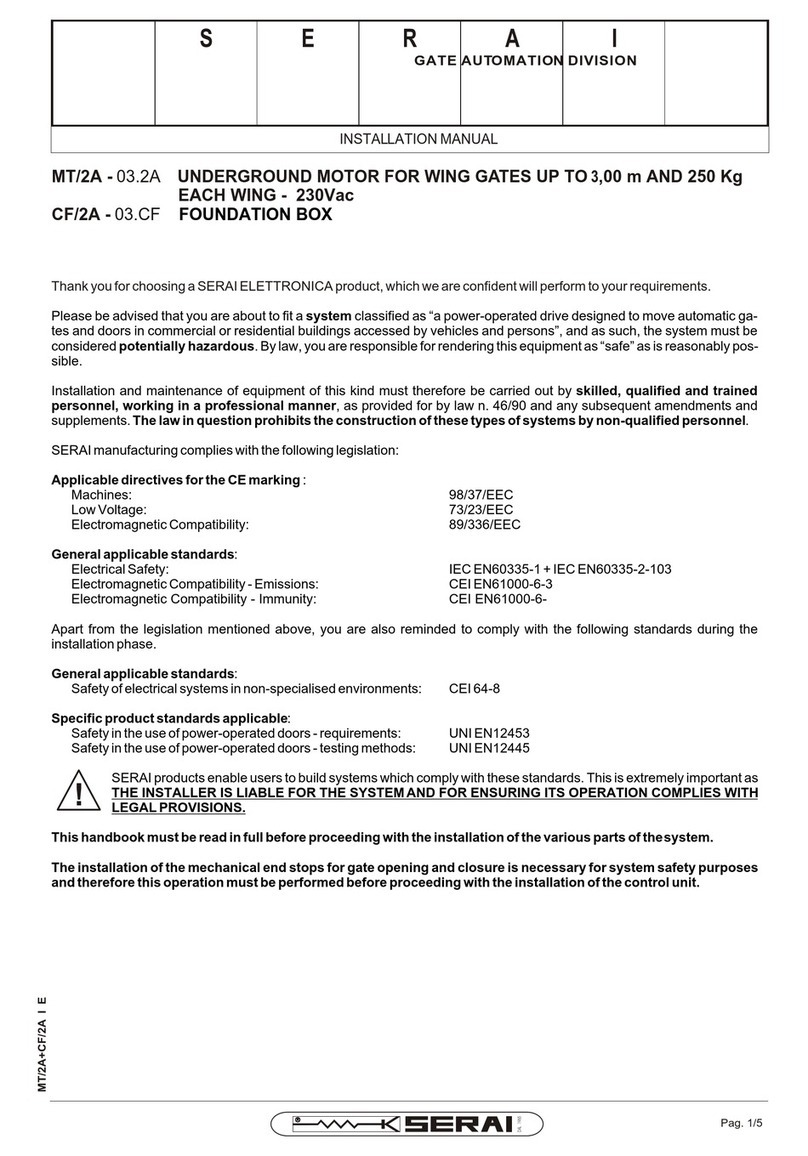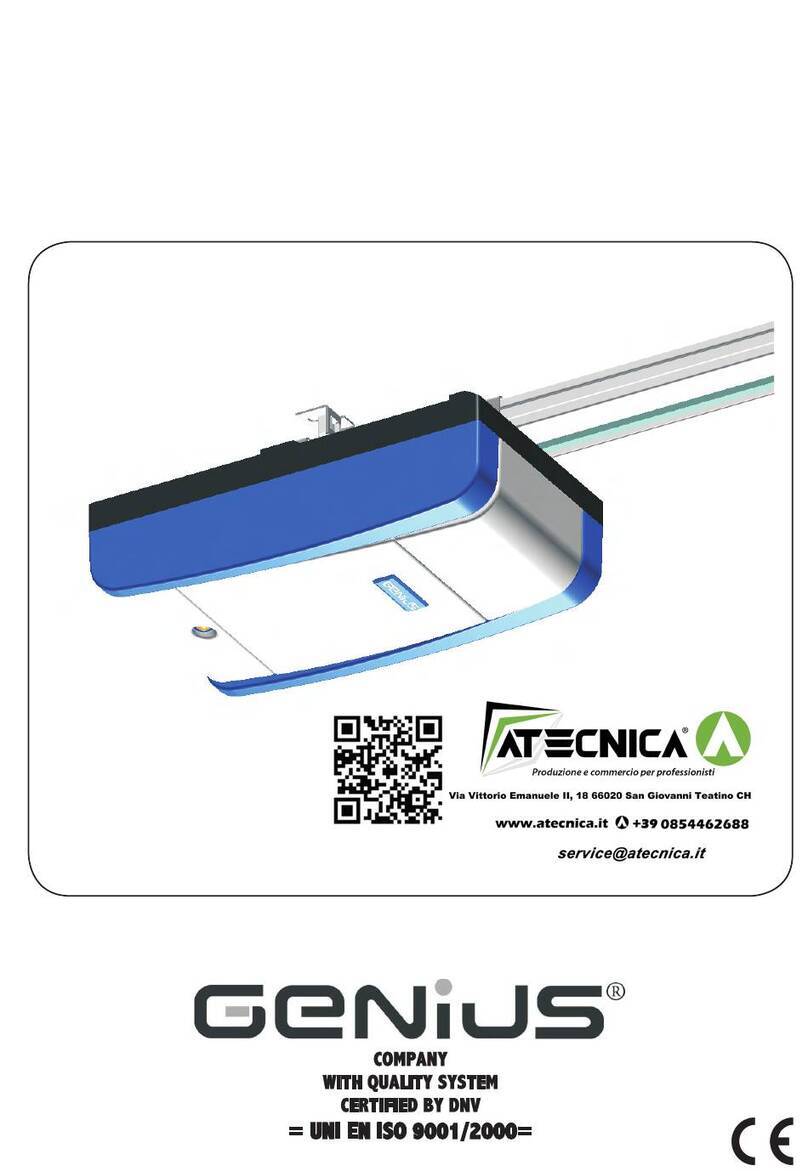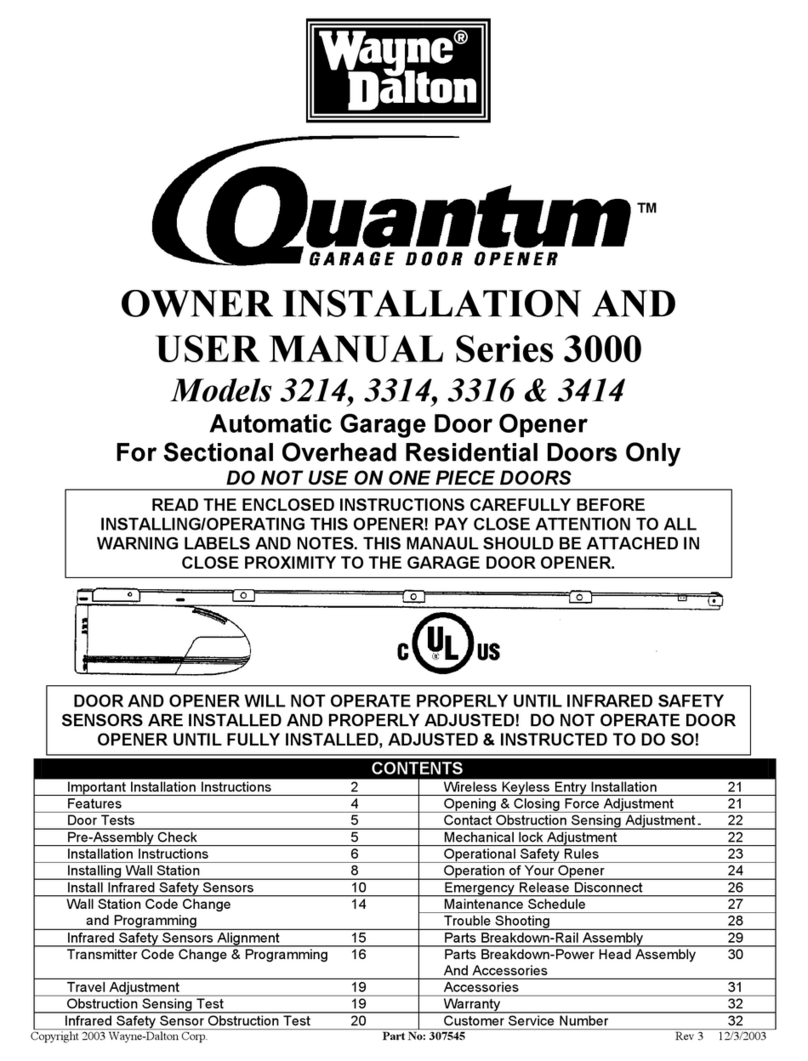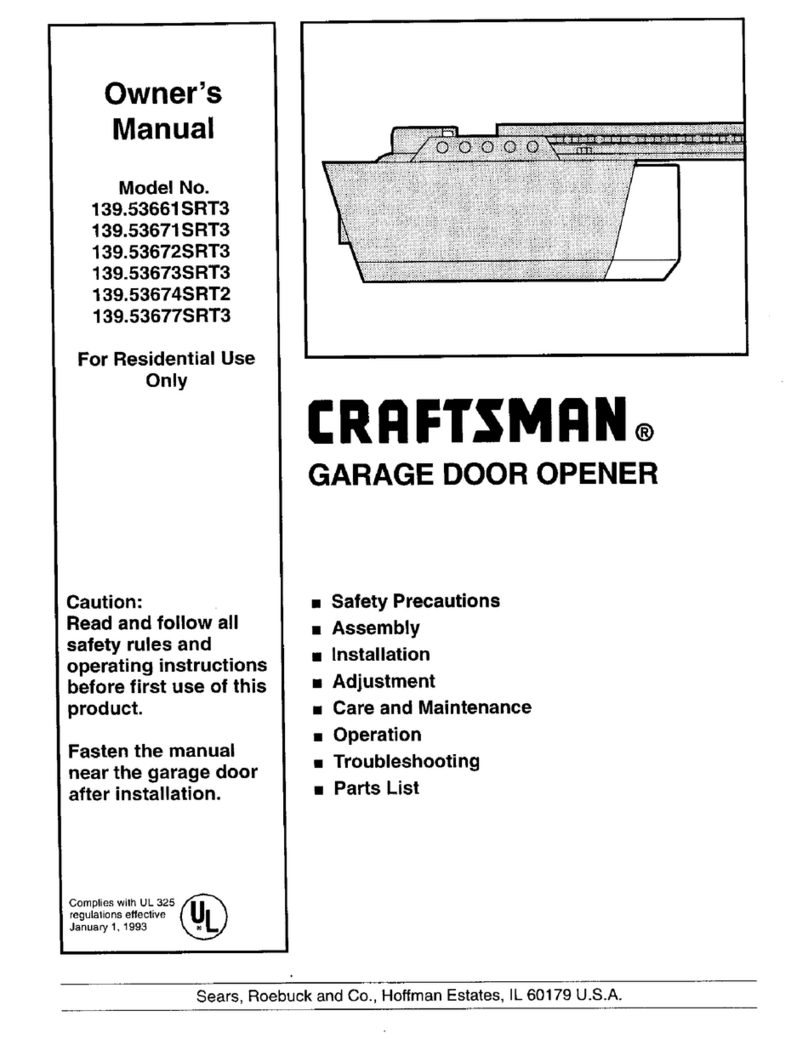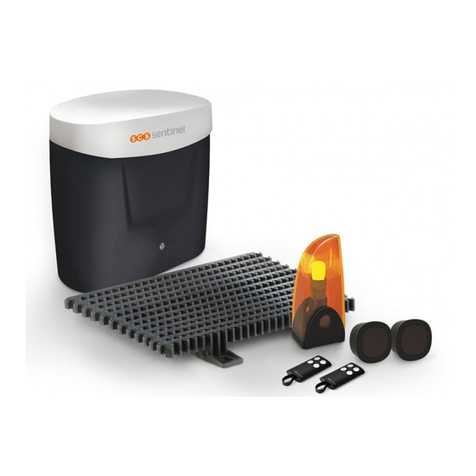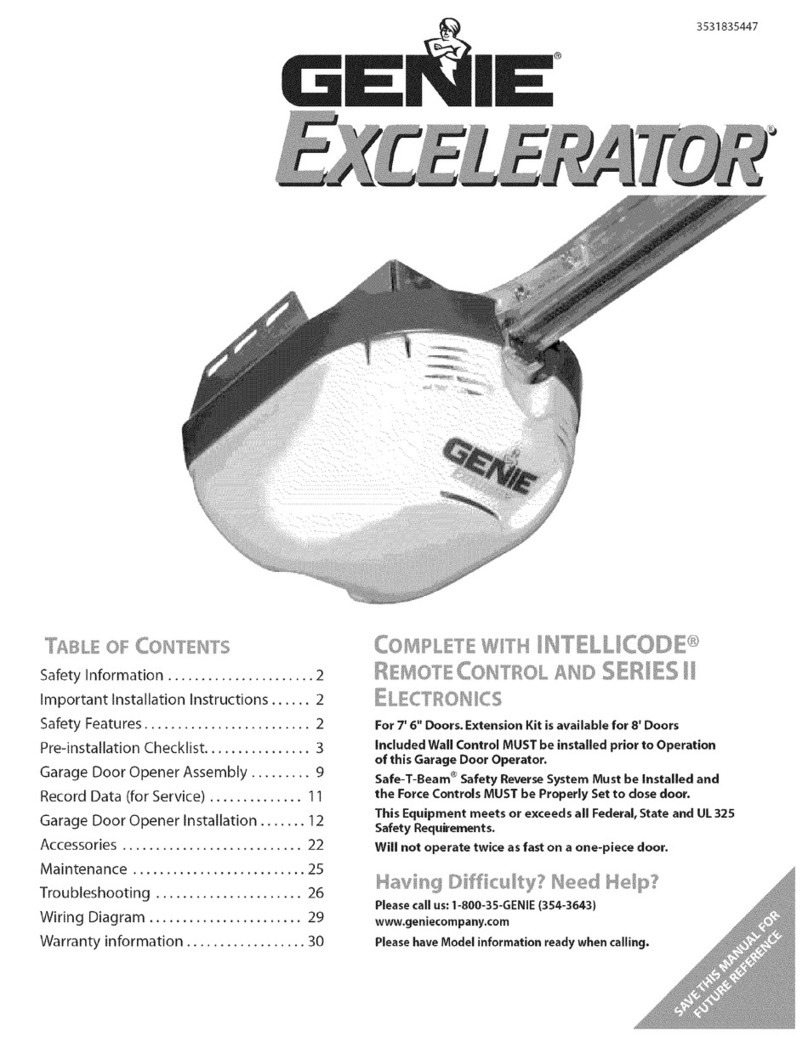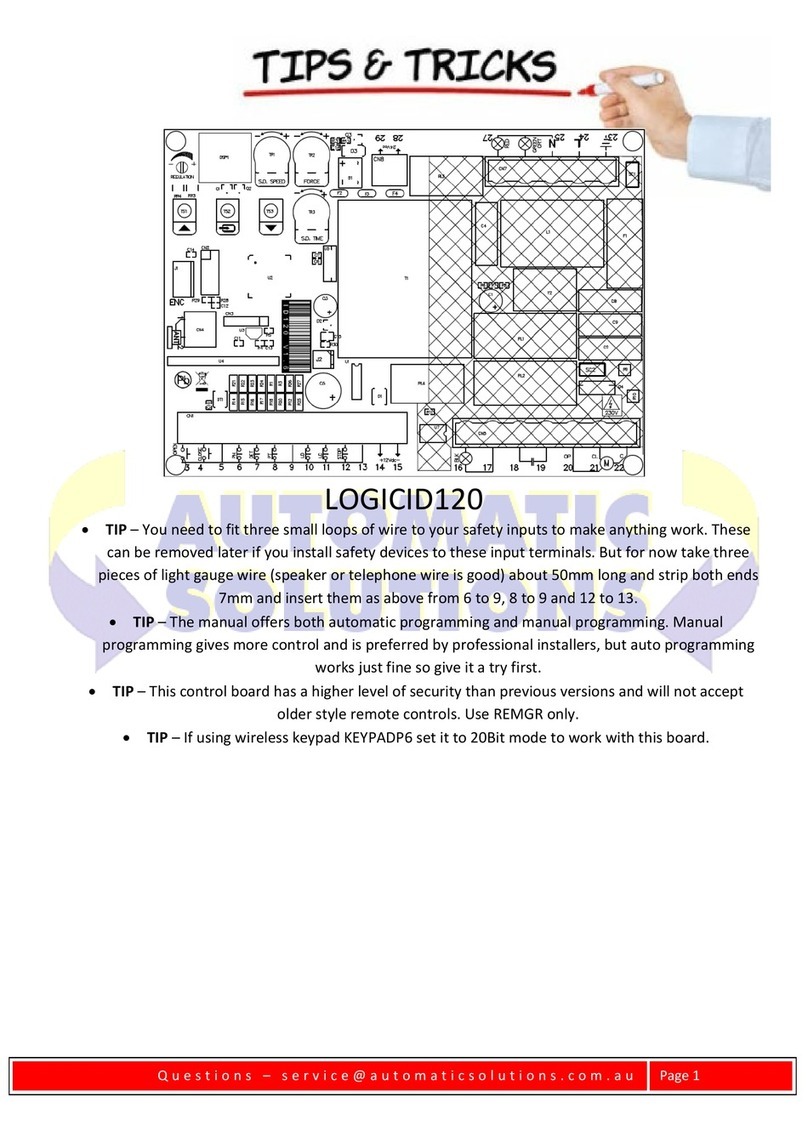Anaheim Automation AD1200 User manual

ANAHEIM GARAGE DOORS
ANAHEIM, CA
Garage Door Opener
Owner’s Manual
FOR RESIDENTIAL USE ONLY
Complies with UL 325
Regulations effective
January 1, 1993
MODEL AD1200 – 1/2HP
MODEL AD800 – 1/3HP
■Please read this manual and the enclosed safety materials carefully!
■Fasten the manual near the garage door after installation.
■The door WILL NOT CLOSE unless the Protector System®is connected and
properly aligned
■Periodic checks and adjustment of the opener are required to ensure safe
operation.
■The model number label is located under the light lens on the front panel of
your opener.
®

Start by reviewing these important safety alert symbols:
2
Contents Page
A review of safety alert symbols . . . . . . . . . . . . . .2
You'll need tools . . . . . . . . . . . . . . . . . . . . . . . . . .3
Illustration of sectional door installation . . . . . . . .4
Illustration of one-piece door installation . . . . . . . .4
Carton inventory . . . . . . . . . . . . . . . . . . . . . . . . . .5
Hardware inventory . . . . . . . . . . . . . . . . . . . . . . . .5
Assembly Section - Pages 6 – 7
Fasten T-rail to opener . . . . . . . . . . . . . . . . . . . .6
Attach chain to sprocket . . . . . . . . . . . . . . . . . . .6
Attach chain spreader, re-install chain . . . . . . . .6
Tighten the chain . . . . . . . . . . . . . . . . . . . . . . . . .7
Installation Section - Pages 8– 23
Installation instruction warnings . . . . . . . . . . . . . .7
Determine header bracket location
(doors with track) . . . . . . . . . . . . . . . . . . . . . . . . .8
Determine header bracket location
(one-piece doors without track) . . . . . . . . . . . . . .9
Install the header bracket . . . . . . . . . . . . . . . . .10
Attach the T-rail to header bracket . . . . . . . . . .11
Position the opener . . . . . . . . . . . . . . . . . . . . . .12
Hang the opener . . . . . . . . . . . . . . . . . . . . . . . .13
Install the door control . . . . . . . . . . . . . . . . . . . .14
Install the lights and lenses . . . . . . . . . . . . . . . .15
Attach manual release rope and handle . . . . . .15
Electrical requirements . . . . . . . . . . . . . . . . . . .16
Contents Page
The Protector System®
Safety reversing sensor information . . . . . . . . .17
Install the safety reversing sensor . . . . . . . . . . .18
Fasten door bracket (sectional door) . . . . . . . . .20
Fasten door bracket (one-piece door) . . . . . . . .21
Connect door arm to trolley (sectional door) . . .22
Connect door arm to trolley (one-piece door) . .23
Adjustment Section - Pages 24 – 26
Travel limit adjustments . . . . . . . . . . . . . . . . . . .24
Force adjustments . . . . . . . . . . . . . . . . . . . . . . .25
Test the Protector System®. . . . . . . . . . . . . . . .26
Test the safety reverse system . . . . . . . . . . . . .26
Operation safety instructions . . . . . . . . . . . . . . . .27
Care of your opener . . . . . . . . . . . . . . . . . . . . . . .27
Maintenance schedule . . . . . . . . . . . . . . . . . . . . .27
Operation of your opener . . . . . . . . . . . . . . . . . . .28
Receiver & remote control programming . . . . . . .29
Having a problem? . . . . . . . . . . . . . . . . . . . . . . .30
Repair parts, rail assembly . . . . . . . . . . . . . . . . .32
Repair parts, installation . . . . . . . . . . . . . . . . . . .32
Repair parts, opener assembly . . . . . . . . . . . . . .33
Accessories . . . . . . . . . . . . . . . . . . . . . . . . . . . . .34
Index . . . . . . . . . . . . . . . . . . . . . . . . . . . . . . . . . .35
How to order repair parts . . . . . . . . . . . . . . . . . . .36
When you see these safety symbols on the following pages, they will alert you to the possibility of
serious injuries or death
if you do not comply with the corresponding instructions. The hazard may
come from something mechanical or from electric shock.
Read the instructions carefully.
When you see this safety symbol on the following pages, it will alert you to the possibility of damage
to your garage door and/or the garage door opener if you do not comply with the corresponding
instructions.
Read the instructions carefully.
This garage door opener is designed and tested to offer safe service provided it is installed, operated,
maintained and tested in strict accordance with the safety instructions contained in this manual.
Mechanical Electrical
WARNING WARNING
CAUTION

3
SECTIONAL DOOR ONE-PIECE DOOR
To avoid damage to the garage door and
opener, disable locks before installing and
operating the opener. Use a wood screw or nail
to hold locks in the “open” (unlocked) position.
Operation at other than 120V 60 Hz will cause
opener malfunction and damage.
CAUTION
Pliers
Wire Cutters
Claw Hammer
Hack Saw
Screwdriver Adjustable End Wrench
1/2" and 7/16" Sockets
and Wrench
Drill
Tape Measure
2
1
Stepladder
Pencil
3/16", 5/16" and
5/32" Drill Bits
Carpenter's
Level
During assembly, installation and adjustment of the opener, instructions will call for hand tools shown below.
You'll Need Tools
WARNING
An unbalanced garage door might not reverse
when required and someone under the door
could be seriously injured or killed.
If your garage door binds, sticks or is out of
balance, call for professional garage door
service.
Garage doors, door springs, cables,
pulleys, brackets and their hardware, are
under extreme tension and can cause serious
injury or death.
Do not try to loosen, move or
adjust them yourself!
Ropes left on a garage door could cause
someone to become entangled and killed.
Remove all ropes connected to the door before
installing and operating the opener.
Identify the type and height of your door, any special
conditions that exist, and any additional materials that
may be required, by referring to page 4.
Test your Door
Before you begin, complete the following test to
make sure your door is balanced, and is not
sticking or binding:
• Lift the door about halfway as shown. Release the
door. It should stay in place, supported entirely by
its springs.
• Raise and lower the door to see if there is any
binding or sticking.

4
You may find it helpful to refer back to this page as you proceed with the installation of your opener.
Safety Reversing Sensor
Horizontal and vertical reinforcement
is needed for lightweight garage doors
(fiberglass, steel, aluminum, door with glass panels, etc.).
See page 20 for details.
Support bracket &
fastening hardware
is required.
See page 13.
— — — — — — — —
Door Center
Header Wall
Safety
Reversing
Sensor
Floor must be level
across width of door
FINISHED CEILING
Extension Spring
Torsion Spring
Access Door
OR
OR
Extension Spring - One-Piece Door
Header
Wall
Door Track
Slack in chain tension
is normal when
garage door is closed.
Before you begin, survey your garage area to see whether any of the conditions below apply to your installation.
SECTIONAL Door or ONE-PIECE Door
with Track Installation
FINISHED CEILING
Support bracket
& fastening
hardware is required.
See page 13.
Slack in chain tension
is normal when
garage door is closed.
Safety Reversing Sensor
Header
Wall
Access Door
Safety Reversing Sensor
Gap between floor and bottom of
door must not exceed 1/4".
ONE-PIECE Door Without Track Installation
Model 1702 Outside Quick Release
required if there is no access door.
Model 1702 Outside Quick Release
required if there is no access door.

Straight Door
Arm Section
Door Bracket Plate
Door Bracket
Curved Door
Arm Section
Safety Labels
and
Literature
Header Bracket
UP
CEILING MOUNT ONLY
Safety Reversing Sensor
Mounting Bracket
With Square Holes (2)
"C" Wrap (2)
Safety Reversing Sensor
Mounting Bracket
With Slot (2)
Safety Reversing Sensor (2)
(1) Sending Eye
(1) Receiving Eye
2-Conductor
Bell Wire
White & White/Red
2-Conductor Bell Wire
with Connector (2 rolls)
White & White/Black
2-Channel Remote Control
Transmitter (1)
with 12V battery
LIGHT
LOCK
Multi-Function
Control Panel
Light Lens (2)
Remote Control
Transmitter Visor Clip
Chain Spreader with
Screws and Washers
One-Piece
T-rail
Styrofoam
Chain
Pulley Bracket
Trolley
Chain
Safety Reversing Sensor
Installation Hardware
Lag Screw 1/4x1-1/2" (4)
Hex Screw 1/4-20x1-1/2" (2)
Carriage Bolts 1/4"-20x1/2" (4)
Screw #10 - 32x3/8" (4)
Lock Nut 1/4"-20 (4)
Lock Nut #10x32 (4)
Wing Nut (2)
Insulated Staples (20)
Installation Hardware
Hex Screw 5/16"-18x7/8" (4)
Hex Screw #8x3/8" (2)
Lag Screw 5/16"-18x1-7/8" (4)
Carriage Bolt 5/16"-18x2-1/2" (2)
Clevis Pin 5/16"x2-3/4" (1)
Clevis Pin 5/16"x1" (2)
Nut 5/16"-18 (6)
Lock Washer 5/16" (6)
Screw 6ABx1" (2)
Insulated Staples (10)
Ring Fastener (3)
Handle
Dry Wall Anchors (2)
Rail Grease
Rope
5
Carton Inventory
Your garage door opener is packaged in two cartons which contain all parts illustrated below. If anything is
missing, carefully check the packing material. Parts may be "stuck" in the foam. Hardware for assembly and
installation is also listed below.

Chain
Spreader
#8x1"
Hex Screw
T-Rail
Flange
Slot
Washers • Guide the chain
around the groove
in the chain
spreader (select the
8-tooth sprocket for
sectional doors or
the 6-tooth sprocket
for one piece
doors) as shown.
6
Assembly Step 1
Fasten the T-Rail to the Opener, Attach
the Chain Spreader and Re-Install the
Chain
Washered
Screws
5/16"-18x1/2"
Chain
T-Rail
Styrofoam
Opener
Sprocket
To fasten rail, use only those screws mounted
in the top of the opener. Any other screws will
cause serious damage to the opener.
Washered Screws
5/16"-18x1/2"
Chain
T-Rail
Opener
Chassis
Styrofoam
Mounting
Plate
• Cut tape from T-rail, chain and styrofoam. See Figure
2. Remove styrofoam and pull the chain back (away
from mounting plate).
• Fasten the rail with the (2) washered screws previously
removed. Tighten securely.
Remember to use only these screws! Any other
screws will cause serious damage to the opener.
USE ONLY THIS
TYPE AND SIZE
SCREW
• Line up the holes in the chain spreader with the holes
in the opener. See Figure 3. The slot in the chain
spreader must fit over the T-rail flange.
• Securely fasten the chain spreader with the hardware
provided.
HARDWARE
SHOWN
ACTUAL
SIZE
8-Tooth
Sprocket
6-Tooth
Sprocket
Chain
Spreader Opener
Mounting Plate
Opener
Mounting Plate
Chain
Spreader
• Separate the
trolley threaded
shaft from the
trolley. Loosen the
inner nut and lock
washer, then
remove the outer
nut.
Chain
Spreader
Chain
Opener Sprocket
To the Trolley
CAUTION
Serious injury can result if fingers become
entangled in moving opener sprocket. Attach
sprocket cover securely. Never operate opener
while your hand is near the opener sprocket.
WARNING
Figure 1
Figure 3
Figure 4
Figure 2
• Place the opener on packing material to protect the
cover.
• Remove the (2) 5/16"-18x1/2" washered screws
mounted in the top of the opener. See Figure 1.
• Align T-rail and styrofoam over opener sprocket.
Trolley
Threaded
Trolley Shaft
Outer Nut
T-Rail
Disconnect Threaded Trolley Shaft from Trolley
Inner Nut
• Continue dispensing the chain forward to the trolley. See
Figure 4. Reconnect the trolley threaded shaft to the
trolley. Proceed to page 7 for chain tensioning instructions.

• Spin the inner nut and lock washer down the
threaded shaft, away from the trolley.
• To tighten the chain, turn outer nut in the direction
shown. As you turn the nut, keep the chain
from twisting.
• When the chain is approximately 1/2" above the
base of the T-rail at its midpoint, re-tighten the
inner nut to secure the adjustment.
Sprocket noise can result if chain is either too
loose or too tight.
When installation is complete, you may notice some
chain droop with the door closed. This is normal. If
the chain returns to the position shown when the
door is open,
do not re-adjust the chain.
NOTE: During future maintenance,
ALWAYS
pull
the manual release handle to disconnect trolley
before adjusting chain.
Lock
Washer
To Tighten Outer Nut Inner Nut
Trolley
Chain
Base of T-rail
1/2"
To Tighten
Inner Nut
Outer Nut
Assembly Step 2
Tighten the Chain
IMPORTANT INSTALLATION INSTRUCTIONS
To reduce the risk of severe injury or death to persons:
1. READ AND FOLLOW ALL INSTALLATION INSTRUCTIONS
2. Install only on a properly balanced and lubricated garage door.
An improperly balanced door
could result in severe injury or death.
Repairs to cables, spring assemblies and other hardware
must be made by a professional service person before installing opener.
3. Disable all locks and remove all ropes connected to the garage door before installing the opener.
Ropes connected to a garage door can cause entanglement and death.
4. If possible, install door opener 7 feet or more above floor with the manual release handle
mounted 6 feet above the floor.
5. Do not connect the opener to power source until instructed to do so.
6. Locate the Door Control within sight of the door at a minimum height of 5 feet where small
children cannot reach and away from all moving parts of the door.
7. Install the User Safety Instruction Label on the wall adjacent to the control button and the
Maintenance Instruction Label in a prominent location on the inside of the garage door.
8. Upon completion of the installation, the door must reverse when it comes in contact with a one-
inch high object (or a 2x4 laid flat) on the floor.
9. Do not wear watches, rings or loose clothing while installing or servicing an opener. Jewelry or
loose clothing can be caught in the mechanism of the garage door or the opener.
7
You have now finished assembling your garage door opener. Please read the following
warnings before proceeding to the Installation section:
WARNING WARNING

• Open your door to the highest
point of travel as shown. Draw
an intersecting horizontal line
on the header wall 2" above
the high point. This height will
provide travel clearance for the
top edge of the door.
Header
Wall
Ceiling
Track
Highest Point
of Travel
Door
2"
8
Proceed to Step 2, page 10.
Door
Track
Header
Wall
Highest Point
of Travel
2"
Vertical
Guideline
Finished
Ceiling
Vertical
Guideline
Header
Wall 2x4 Structural
Supports
SECTIONAL Door and
ONE-PIECE Door With Track
• Close the door and mark the inside
vertical centerline of the garage door.
• Extend the line onto the header wall
above the door.
Remember, you can fasten the
header bracket within 2 feet to the
left or right of the door center
only
if
a torsion spring or center bearing
plate is in the way; or you can attach
it to the ceiling (refer to page 10)
when clearance is minimal. (It may
be mounted on the wall upside down
if necessary, to gain approximately
1/2".)
If you need to install the header bracket
on a 2x4 (on wall or ceiling), use lag
screws (not supplied) to securely fasten
the 2x4 to structural supports as shown
here and on page 9.
Installation Section: Pages 8 – 23
Sectional door
with curved track One-piece door
with horizontal track
Installation Step 1
Determine Header Bracket Location
Installation procedures vary according to
garage door types. Follow the instructions
which apply to your door.
If the header bracket is not rigidly fastened to
a structural support on the header wall or
ceiling, the safety reverse system may not
work properly (see page 26).
The door might
not reverse when required, and could cause
serious injury or death.
The garage door springs, cables, pulleys,
brackets and their hardware are under extreme
tension.
Do not attempt to loosen, move or
adjust them yourself. Serious personal injury or
death could result.
Call for garage door service.
WARNING

Header Wall Vertical
Centerline
Vertical
Centerline of
Garage Door
2x4
Unfinished
Ceiling
Structural Supports
2x4
OPTIONAL CEILING MOUNT
FOR HEADER BRACKET
• Close the door and mark the
inside vertical centerline of
your garage door. Extend the
line onto the header wall
above door.
If headroom clearance is
minimal, you can install the
header bracket on the ceiling.
See page 10.
•
If you need to install the
header bracket on a 2x4 (on
wall or ceiling), use lag screws
(not supplied) to securely
fasten the 2x4 to structural
supports as shown.
EXAMPLE
Distance from top of door
(at highest point of travel) to floor...........................92"
Actual height of door.............................................-88"
Remainder................................................................4"
Add.........................................................................+8"
Bracket height on header wall..............................=12"
(Measure UP from top of CLOSED door.)
Proceed to Step 2, page 10.
9
Header Wall
Highest Point
of Travel
Door
Distance
Jamb
Hardware
ONE-PIECE Door Without Track
• Open your door to the highest point of travel as
shown. Measure the distance from the top of the
door to the floor. Subtract the actual height of the
door. Add 8" to the remainder. (See Example).
• Close the door and draw an intersecting horizontal
line on the header wall at the determined height.
If the total number of inches exceeds the height
available in your garage, use the maximum
height possible, or refer to page 10 for ceiling
installation.
Door
Highest Point
of Travel
Header
Wall
Pivot
Distance
Header Wall
Highest Point
of Travel
Door
Distance
Jamb
Hardware
One-piece door without track
Jamb Hardware One-piece door without track
Pivot Hardware
Read the Safety Instructions on page 8. They also apply to doors without tracks.

Lag Screws
5/16"x18x1-7/8"
Highest
Point of Travel
(of Garage Door)
Vertical
Center
Line
Header
Wall
Garage
Door
UP
CEILING MOUNT ONLY
Wall
Mounting Holes
Optional
Wall Mounting
Holes
The nail hole is for positioning
only. You must use lag screws to
mount the header bracket.
UP
CEILING MOUNT ONLY
2"
Door
Spring
Header
Bracket
2x4
Structural
Support
Vertical
Center
Line
10
UP
CEILING MOUNT ONLY
Ceiling Mounting Holes
The nail hole is for positioning only.
You must use lag screws to mount
the header bracket.
You can attach the header bracket either to the
wall above the garage door, or to the ceiling.
Follow the instructions which will work best for
your particular requirements.
Fasten the Header Bracket to the Wall
• Center the bracket on the vertical guideline with
the bottom edge of the bracket on the horizontal
line as shown (with the arrow pointing toward the
ceiling).
• Mark either set of bracket holes (do not use the
holes designated for ceiling mount). Drill 3/16" pilot
holes and fasten the bracket securely to a structural
support with the hardware provided.
• Extend the vertical guideline onto the ceiling as
shown.
• Center the bracket on the vertical mark, no more than
6" from the wall. Make sure the arrow is pointing
toward the wall. The bracket can be mounted flush
against the ceiling when clearance is minimal.
• Mark holes designated for ceiling mount only. Drill
3/16" pilot holes and fasten the bracket securely to
a structural support with the hardware provided.
Fasten the Header Bracket to the Ceiling
Installation Step 2
Install the Header Bracket
Lag Screw
5/16"-18x1-7/8"
Hardware Shown Actual Size
UP
Lag Screws
5/16"x18x1-7/8"
Garage
Door
Vertical
Center Line
Header
Wall
Finished
Ceiling
Header
Bracket
6" Maximum
Vertical
Center Line
Door
Spring

Header
Bracket
Chain
Pulley
Bracket
Temporary
Support
Header Wall
Garage
Door
T-rail
Clevis Pin
5/16"x2-3/4 "
Ring Fastener
Header Bracket
Chain
Pulley
Bracket
T-rail
INCREASE TRAVEL
DOWN UP
• Position the opener on the garage floor below the
header bracket. Use packing material as a
protective base.
If the door spring is in the way you'll need help.
Have someone hold the opener securely on a
temporary support to allow the T-rail to clear the
spring.
• Position the chain pulley bracket against the header
bracket.
• Align the bracket holes and join with a clevis pin as
shown.
• Insert a ring fastener to secure.
11
Installation Step 3
Attach the T-rail to the Header Bracket
Clevis Pin
5/16"x2-3/4" Ring Fastener
Hardware Shown Actual Size

Installation Step 4
Position the Opener
Follow instructions which apply to your door
type as illustrated.
To prevent damage to steel, aluminum,
fiberglass or glass panel doors, do not rest the
opener on the door without using a 2x4.
SECTIONAL Door & ONE-PIECE Door with Track
A 2x4 laid flat is convenient for setting an ideal
door-to-T-rail distance.
• Raise the opener onto a stepladder.
You will need help at this point if the ladder is
not tall enough.
• Open the door all the way and place a 2x4 laid flat
on the top section beneath the T-rail.
If the top panel hits the trolley when you raise
the door, pull down on the trolley release arm to
disconnect the inner and outer sections. The
trolley can remain disconnected until Step 12 is
completed.
• With the door fully open and parallel to the floor,
measure the distance from the floor to the top of
the door.
• Using a stepladder as a support, raise the opener
to the same distance as the door from the floor (it
will be at a slight angle as shown).
• The top of the door should be level with the top of
the opener. Do not position the opener more than
2" above this point.
T-rail 2x4
Door
Top of Opener
Header
Bracket
Top of Door
12
CAUTION
Trolley
Trolley
Release Arm
ONE-PIECE Door without Track

Installation Step 5
Hang the Opener
Two representative installations are shown.
Yours may be different. Hanging brackets should
be angled, Figure 1, to provide rigid support. On
finished ceilings, Figure 2, attach a sturdy metal
bracket to structural supports before installing the
opener. The bracket and fastening hardware are not
supplied.
• Measure the distance from
each
side of the opener
to the structural support.
• Cut both pieces of the hanging bracket to required
lengths.
• Drill 3/16" pilot holes in the structural supports.
• Attach one end of each bracket to a support with
5/16"x1-7/8" lag screws.
• Fasten the opener to the hanging brackets with
5/16"-18x7/8" hex screws, lock washers and nuts.
• Check to make sure the T-rail is centered over the
door (or in line with the header bracket if the
bracket is not centered above the door).
• Remove the 2x4. Operate the door manually. If the
door hits the rail, raise the header bracket.
Grease the top and underside of
the rail surface where the
trolley slides with rail
grease.
Bracket
(Not Supplied)
Lag Screws
5/16"x1-7/8"
(Not Supplied)
5/16"-18x7/8" Screw
5/16" Lock Washer
5/16"-18 Nut
— FINISHED CEILING —
Hidden
Support
5/16"-18x7/8" Screw
5/16" Lock Washer
5/16"-18 Nut
13
The opener could fall and injure someone if it is
not properly secured.
Fasten the opener
securely to structural supports of the garage.
Lag Screw
5/16"-18x1-7/8"
Hex Screw
5/16"-18x7/8" Nut 5/16"-18 Lock Washer 5/16"
Hardware Shown Actual Size
WARNING
Measure
Distance
Lag Screws
5/16"x1-7/8"
5/16"-18x7/8" Screw
5/16" Lock Washer
5/16"-18 Nut
Structural Supports
Figure 1
Figure 2
RAIL GREASE
NO. 83A4

Installation Step 6
Install the Door Control
14
Children operating or playing with a garage door
opener can injure themselves or others.
The
garage door could close and cause serious
injury or death.
Install the door control (or any additional push
buttons) out of the reach of children and away
from all moving parts of the door and door
hardware,
but where the garage door is visible.
Do not allow children to operate the push
button(s) or the remote control transmitter(s).
A moving garage door could injure someone
under it.
Activate the opener only when the door
is properly adjusted, you can see it clearly, and
there are no obstructions to door travel.
Opener
Terminal
Screws2-Conductor Bell Wire
Antenna
Back Panel
of Opener
The Chamberlain Group, Inc
Step 6 Install Lighted Door Control Button
CGI Multifunction/Pushbutton
10/8/91 - 5/2/92 - 5/4/92 - 5/26/92
Door
Control
Terminal
Screws
2-Conductor
Bell Wire
WHT
RED
Door Control
Push Bar
LIGHT
LOCK
RED
Multi-Function
Door Control Panel
WHITE
Light Button
Lock Button
Multi-Function
Door Control Panel
Terminal Screws 2-Conductor
Bell Wire
KG KG
M.D.C. CERT. NO.
1
3
9
75
132C2105-1
PART NO: Nº DE PIÈCE:
D.O.C. CERT. NO. DATE:
Sears Roebuck & Co.
Sears Canada Inc., Toronto
Assembled in Mexico - Assemblé du Mexique
PAT. #RE29,525; 4,750,201; 4,806,930 Other Patents Pending.
AVERTISSEMENT: Pour réduire les risques de
blessures mortelles par happement, après tout
réglage de la force de déclenchement ou des
seuils de fin de course s'assurer que le sens de
la course s'inverse lorsque la porte entre en
contact avec un object de 13 mm (1 po) de
hauteur (ou un madrier de 2 x 4 de section, à
plat) posé sur le sol. Effectuer les reglages
selon les procédures décrites dans la notice.
1
3
9
75
23
1
2
1
• Strip 1/4" of insulation from one end of the bell
wire; connect the wire to the two screw terminals
on the back of the door control: white to 2, and
white/red to 1.
•Locate the door control within sight of the door
at a minimum height of 5 feet where small
children cannot reach, and away from all
moving parts of the door and door hardware.
Fasten the Multi-Function Door Control Panel
securely with 6ABx1" screws. If installing into
drywall, drill 5/32" holes and use the anchors
provided.
• Run the bell wire up the wall and across the ceiling
to the opener. Use insulated staples to secure the
wire in several places. Be careful not to pierce the
wire with a staple, thereby resulting in a short.
• Receiver terminal screws and the antenna are
located on the back panel of the opener. Position
the antenna wire as shown.
• Then connect the bell wire to the opener terminal
screws: white to 2 and white/red to 1.
• Remember to affix the User Safety Instruction
label to the wall near the door control, and the
Maintenance Instruction label in a prominent
location on the inside of the garage door.
If the label adhesive will not adhere to your garage
wall surface (or becomes loose with time) use tacks
to secure the label alongside the door control.
Page 28 explains how to operate the opener using
the door control push bar and the Lock and Light
features.
Dry Wall Anchors
Insulated
Staples
6ABx1" Multi-Function
Door Control Panel Screw
Hardware Shown Actual Size
Outside Keylock Accessory Connections
To opener terminal screws: white to 2; white/red to 1
WARNING
Do NOT connect the power and operate the
opener at this time.
The trolley will travel to the
full
open
position but will not return to the
close
position until the sensor beam is
connected and properly aligned.
See Safety Reversing Sensor instructions
beginning on page 17.

15
Install the lights
• Install a 75 watt maximum light bulb in each
socket. The lights will turn ON and remain lit for
approximately 4-1/2 minutes when power is
connected. Then the lights will turn OFF.
• If the bulbs burn out prematurely due to vibration,
replace with a standard-neck "Garage Door
Opener" bulb.
Install the lenses
• Slide lens into the guides. Snap bottom tabs into
lens slots.
• Reverse the procedure to remove the lenses
Installation Step 7
Install the Lights and the Lenses
Installation Step 8
Attach the Manual Release
Rope and Handle
Do not use the red handle to pull the door
open or closed.
The rope knot could become
untied and you could fall.
Use the manual
release only to disengage the trolley and, if
possible, only when the door is closed.
Garage doors are heavy. If the door is open
when the handle is pulled, the door could
close inadvertently if it is not properly
balanced. Serious injury may result to persons
under the door. Make sure the doorway is clear
of persons and obstructions before pulling
handle when the door is open.
• Thread one end of the rope through the hole in the
top of the red handle so "NOTICE" reads right side
up as shown. Secure with an overhand knot.
The knot should be at least 1" from the end of the
rope to prevent slipping.
• Thread the other end of the rope through the hole in
the release arm of the outer trolley.
• Adjust rope length so the handle is 6 feet above the
floor. Secure with an overhand knot.
If it is necessary to cut the rope, heat seal the cut
end with a match or lighter to prevent unraveling.
Trolley
NOTICE
Overhand
Knot
Manual
Release Handle
Rope
Overhand
Knot
Trolley
Release Arm
Lens
Guide
Lens
Tab
Lens
Slot
75 Watt
(Maximum)
Light Bulb
WARNING

To reduce the risk of electric shock, your garage
door opener has a grounding type plug with a third
grounding pin. This plug will fit
only
into a grounding
type outlet.
If the plug doesn't fit into the outlet you have,
contact a qualified electrician to install the proper
outlet.
RIGHT WRONG
Installation Step 9
Electrical Requirements
Ground Tab
Green Ground
Screw
Ground Wire
Black
Wire
Permanent wiring
connection
White Wire
Black
Wire
To make a permanent connection through the
7/8" diameter hole in the top of the opener
(according to local code):
• Remove the opener cover screws and set the
cover aside.
• Remove the attached 3-prong cord.
• Connect the black (line) wire to the screw on the
brass terminal; the white (neutral) wire to the
screw on the silver terminal; and the ground wire
to the green ground screw.
The opener must be
grounded.
• Reinstall the cover.
16
To prevent electrocution or fire,
installation
and wiring must be in compliance with local
electrical and building codes.
Permanent wiring
connection
Right Wrong
To avoid installation difficulties,
do not run the opener at this time.
To avoid installation difficulties,
do not run the opener at this time.
• Do not change the plug in any way.
• Do not use a 2-wire adapter.
• Do not use an extension cord.
If permanent wiring is required by your local code, refer to the following procedure:
To prevent electrocution, remove power
from the garage door opener
and
from the
circuit you plan to use for the permanent
connection.
WARNING
WARNING

Invisible Light Beam
Protection Area
Sensor Beam
4-6" max.
above floor
Sensor Beam
4-6" max.
above floor
The safety reversing sensor
must
be connected
and aligned correctly before the garage door
opener will move in the down direction. This is a
required safety device and cannot be disabled.
Installation procedures are the same for sectional
and one-piece doors.
Without a properly working safety reversing
sensor, persons (particularly children) could
be injured or killed by a closing garage door.
Read and follow all instructions.
To protect small children, install the safety
reversing sensor so that the beam will be no
higher than 4"-6" above the garage floor.
Disconnect power to the garage door opener
before installing the safety reversing sensor.
Figure 1: Facing the door from inside the garage
The brackets
must
be securely fastened to a solid
surface such as the studs on either side of the door,
or add a piece of wood at each location if installing in
masonry construction.
The invisible light beam path must be unobstructed.
No part of the garage door (or door tracks, springs,
hinges, rollers or other hardware) can interrupt the
beam while the door is closing. If it does, use a piece
of wood to build out each sensor mounting location to
the minimum depth required for light beam clearance.
17
The Protector System®
Information you'll need before you begin the installation of the safety reversing sensor.
Be sure power to the opener is disconnected.
The sending eye transmits an invisible light beam to
the receiving eye.The units can be installed on
either side of the garage door as long as the sun
never shines directly into the receiving eye lens.
Look at the label on the connector end of each case
to identify the sensors.
The brackets must be connected and fastened so
that the sending and receiving eyes face each other
as shown in Figure 1.
If an obstruction breaks the light beam while the
garage door is closing, the door will stop and
reverse to full open position, and the opener lights
will flash for 5 seconds.
WARNING

1/4x1-1/2"
Lag Screw
#10-32x3/8"
Screw 1/4"-20
Lock Nut
#10x32
Lock Nut Staples 1/4"-20x1/2"
Carriage Bolts
Installation Step 10
Install the Safety Reversing Sensor
(Receiving and Sending Eyes)
Mounting Bracket
With Square Holes
#10-32x3/8"
Screws
"C" Wrap
#10 - 32
Lock Nuts
Garage WALL or DOOR TRACK Installation
Figures 2 , 3 and 4 show recommended assembly
of bracket(s) and "C" wrap based on the
wall
installation of the sensors on each side of the garage
door as shown on page 17, or on the
garage door
tracks
themselves.
Figures 5 and 6 are variations which may fit your
installation requirements better. Make sure the
wraps and brackets are aligned so the sensors
will face each other across the garage door.
Garage Wall or Door Track
Installation Procedure
• Fasten the "C" wraps to the mounting brackets
having square holes, using the hardware shown in
Figure 2.
Garage Wall
Installation Procedure
• Connect each assembly to a slotted bracket, using
the hardware shown in Figure 3. Note alignment
of brackets for left and right sides of the door.
• Finger tighten the lock nuts.
• Use bracket mounting holes as a template to locate
and drill (2) 3/16" diameter pilot holes on both sides
of the garage door, 4"-6" above the floor but not
exceeding 6". (See warning on page 17.)
• Attach bracket assemblies with 1/4"x1-1/2" lag
screws as shown in Figure 3.
• Adjust right and left side bracket assemblies to the
same distance out from mounting surface. Make
sure all door hardware obstructions are cleared.
Tighten the nuts securely.
Garage Door Track
Installation Procedure
Discard slotted bracket. Drill 3/8" holes in each track
and fasten securely with hardware as shown in
Figure 4.
"C" Wrap
Inside
Garage
Wall
Mounting Bracket
with Square Holes
Mounting Bracket
with Slot
Alternate Wall Mount
Sensor
Garage
Floor
Indicator Light
Garage
Floor
Inside
Garage
Wall
Alternate Floor Mount
Mounting Bracket
with Slot
Mounting Bracket
with Square Holes
"C" Wrap
Sensor
Indicator Light
Attach with
concrete anchors
(not provided)
18
Hardware Shown Actual Size
Mounting Bracket
with Slot
1/4" - 20
Lock Nuts
1/4 x 1-1/2"
Lag Screws
1/4-20 x 1/2" Carriage Bolts
(with square shoulder)
Inside
Garage
Wall
"C" Wrap
Mounting Bracket
with Square Holes
Garage WALL Installation
Inside
Garage
Wall
"C" Shaped
Wrap
Mounting Bracket
with Square Holes
1/4-20 x 1/2"
Carriage Bolts
1/4 " Lock Nuts
Drill 3/8"
Holes
Garage
Door Track
Garage DOOR Track Installation
Figure 2
Figure 3
Figure 4
Figure 5 Figure 6

"C" Wra
p
Wire
Wing Nut
Invisible Light Beam
Protection Area
Sensor
Sensor
Connect Wire to
Opener Terminals
Bell Wire
Bell Wire Finished
Ceiling
OPENER TERMINAL SCREWS
Sensor
Connections
Wall Control
Connections
(dotted line) 123
• Run paired wires from both sensors to the opener.
Use insulated staples to secure the wire to wall
and ceiling.
• Strip 1/4" of insulation from each set of wire.
Separate white and white/black wires sufficiently to
connect to the opener terminal screws: white to 2
and white/black to 3.
Plug in the opener. Green indicator lights in both the
sending and receiving eyes will
glow steadily
if
wiring connections and alignment are correct.
If the indicator light is
off
in the
receiving eye
(and
the invisible light beam path is not obstructed),
alignment is required.
• Loosen the receiving eye wing nut to allow slight
rotation of unit. Adjust sensor vertically and/or
horizontally until the green indicator light
glows
with a steady light
• When indicator lights are
glowing steadily
in both
units, tighten the wing nut in the receiving eye unit.
19
Push connector in
until you hear a click
Tab should be
flush with back
of connector
• Insert the wire connector into each
sensor and push until you hear a
click, Figure 7. The white tab on the
sensor should be flush with the back
of the connector.
Wire Connector
White Tab
Safety Sensor
Trouble Shooting
1. If the
sending eye
indicator light does not
glow
steadily
after installation, check for:
• Electric power to the opener.
• A short in the white or white/black wires. These
can occur under staples or at screw terminal
connections.
• Incorrect wiring between sensors and opener.
• An open wire (wire break).
2. If the sending eye indicator light
glows steadily
but
the receiving eye indicator light doesn't:
• Check alignment.
• Check for an open wire to the receiving eye.
1/4-20x1-1/2"
Hex Bolt
Wing Nut
Hardware Shown Actual Size
1/4-20 x 1-1/2"
Hex Bolt
"C" Wrap Wire
Sensor
Wing Nut
Indicator Light
• Center each sensor unit in a "C" wrap with lenses
pointing toward each other across the door.
• Secure sensors with the hardware shown in
Figure 8. Finger tighten the wing nut on the
receiving eye
to allow for final adjustment.
Securely tighten the
sending eye
wing nut.
Figure 8
Figure 7

Installation Step 11
Fasten Door Bracket
Follow instructions which apply to your door
type as illustrated below or on page 21. To prevent damage to steel, aluminum,
fiberglass or glass panel doors, always
reinforce the inside of the door both vertically
and horizontally with an angle iron.
A horizontal brace should be long enough to be secured to 2 vertical supports. A vertical brace should
cover the height of the top panel.
The illustration shows one piece of angle iron as the horizontal brace. For the vertical brace, 2 pieces of
angle iron are used to create a "U"-shaped support. The best solution is to check with your garage door
manufacturer for an opener installation, door reinforcement kit.
• Center the door bracket on the previously marked
vertical guideline used for the header bracket
installation.
• Position the bracket on the face of the door within
the following limits:
A) The top edge of the bracket 2"-4" below the top
edge of the door.
B) The top edge of the bracket directly below any
structural support across the top of the door.
• Mark and drill 5/16" left and right fastening holes.
Secure the bracket as shown in Figure 1 if there is
vertical reinforcement.
If your installation doesn't require vertical reinforce-
ment but does need top and bottom fastening holes
for the door bracket, position the door plate over the
door bracket as shown in Figure 2. Fasten securely
with hardware shown in Figure 1.
20
Vertical
Guideline Door
Bracket
Nut
5/16"-18
Carriage Bolt
5/16"-18x2-1/2"
Lock Washer
5/16"
Vertical
Guideline
Door
Bracket
Location
Header
Bracket
Door
Bracket
Door Bracket
Plate
Inside Edge
of Door or
Reinforcement Board
Horizontal and vertical reinforcement
is needed for lightweight garage doors
(fiberglass, aluminum, steel,
doors with glass panel, etc).
Vertical
Reinforcement
SECTIONAL Door Installation Procedure
Figure 1
Figure 2
CAUTION
This manual suits for next models
1
Table of contents
Other Anaheim Automation Garage Door Opener manuals
Popular Garage Door Opener manuals by other brands

Chamberlain
Chamberlain Garage Door Opener quick start guide

GOGOGATE
GOGOGATE Gate user manual
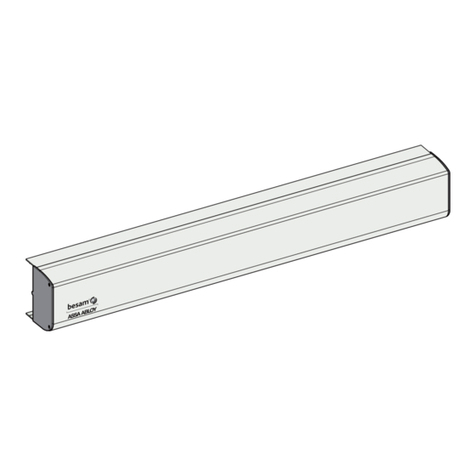
Assa Abloy
Assa Abloy Besam PowerSwing CSDB Installation and service manual
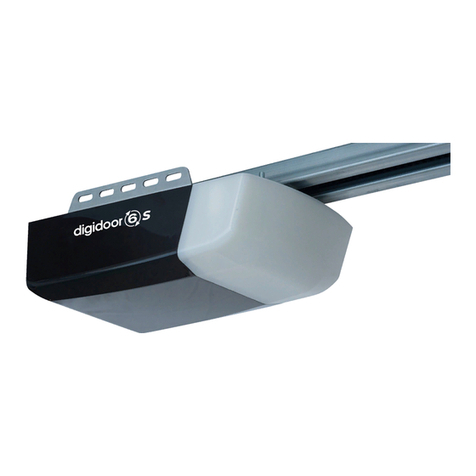
Hydro
Hydro DiGi Digidoor 6 S Installation instructions and user guide
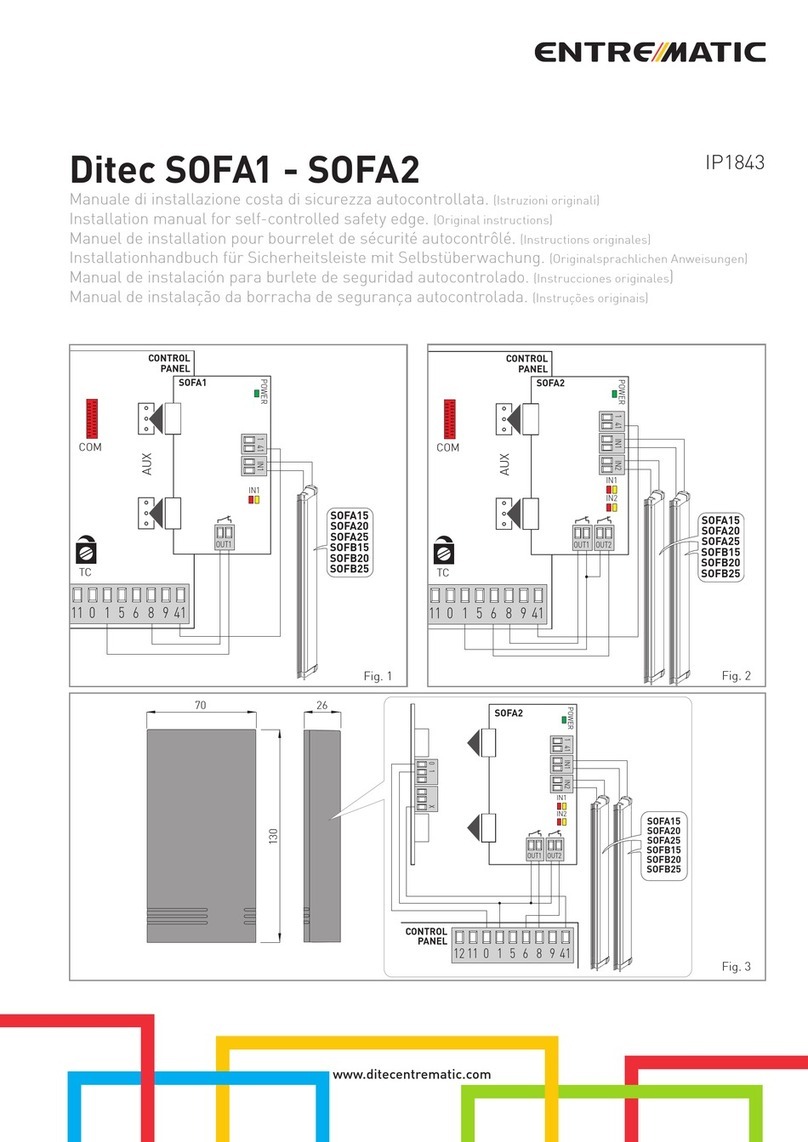
Entrematic
Entrematic Ditec SOFA1 installation manual

Entrematic
Entrematic Ditec Energy 0DT828 installation manual
